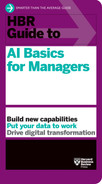Glossary of Key AI Terms
Algorithm. A sequence of instructions used to solve a problem, reach an outcome, or perform a computation. An algorithm can be simple, such as the recipe to bake a cake, or extremely complex, such as those that power internet search engines or self-driving cars. Algorithms may require human intervention to improve, or they may be machine learning algorithms that improve over time when they are trained with new data.
Analytics. The systematic computational analysis of data or statistics, used for the discovery, interpretation, and communication of meaningful patterns. Organizations may apply analytics to data to describe, predict, and improve performance. As analytics capabilities progress in an organization, they may go through stages of descriptive analytics (what happened), diagnostic analytics (why it happened), predictive analytics (what will happen), and prescriptive analytics (how to change what will happen).
Artificial intelligence (AI). The branch of computer science dealing with decision-making or prediction capabilities demonstrated by machines. In the business context, AI is usually supported by machine learning algorithms that make progressively better decisions or predictions over time.
Automation. The act or process of converting the controlling of a machine or device to a more automatic system, such as computer controls. Machine learning algorithms have vastly increased the number of cognitive tasks that can be automated.
Black box. A system whose inputs and outputs can be easily known, but whose internal workings are too complicated or hidden to be easily understood. An AI algorithm may have a black-box problem if its designers cannot determine why its output or prediction is unexpected, incorrect, or biased. An algorithm with a black-box problem might be described as lacking transparency or explainability.
Correlation. A measure of the statistical relationship between variables, indicating both the strength and direction of the relationship. Correlation is often confused with causality, the relationship between something that happens and the thing that causes it. For example, the appearance of umbrellas on a given day has a correlative relationship, but not a causal one, with raincoats.
Labeled data. Data provided to a machine learning algorithm with context or tagging. For example, a picture of a bird that is labeled “bird” or “animal” or “feather” or “wings.”
Linear regression. A mathematical means of sorting out whether there’s a relationship between two or more variables. It answers the questions: Which factors matter most? Which can we ignore? How do those factors interact with each other? And, how certain are we about all of these factors?
Machine learning (ML). A field concerned with the design and development of algorithms and techniques that allow computers to keep improving their performance over time without human intervention. The vast majority of AI in business is forms of machine learning.
MLOps (machine learning operations). A discipline that seeks to establish platforms and processes, and provides tools that make building, deploying, and maintaining AI systems faster, easier, and more reliable.
Natural language processing (NLP). A branch of AI focused on how computers can process language like humans do. Emerging business uses of NLP include speech recognition, language understanding, and language generation.
Overfitting. Overfitting occurs when a statistical model has too many parameters relative to the size of the sample. A model that suffers from overfitting may do a good job describing outcomes that already happened, but it won’t predict future outcomes well. Overfitting is a risk if a machine learning algorithm is trained with poor or too little data.
Reinforcement learning. A branch of machine learning that optimizes tasks by learning from outcomes over time without requiring external training data. Applications of reinforcement learning include game-playing AIs, music or video recommendations, and optimized energy consumption.
Robotic process automation (RPA). RPA technology automates digital and physical tasks. RPA initiatives may or may not incorporate machine learning algorithms to improve over time. Uses of RPA include banking and finance process automation, data extraction, and customer care.
Supervised learning. A type of machine learning in which an algorithm is trained on labeled data. This requires the algorithm to learn from training data then apply learnings to new situations. Applications of supervised learning include stock price prediction, image classification, and facial recognition.
Training data. A data set (usually a very large one) that can be used to train a machine learning algorithm. The quality, amount, and in some cases recentness of your training data will affect a machine learning algorithm’s ability to make better decisions or predictions.
Unlabeled data. Data provided to a machine learning algorithm without any context or tagging. For example, an image of a bird that is provided with no accompanying tag or text.
Unsupervised learning. A branch of machine learning that learns patterns from unlabeled data. Applications include targeted marketing, recommendation systems, and big-data visualization.
